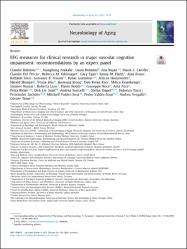EEG measures for clinical research in major vascular cognitive impairment: recommendations by an expert panel

Göster/
Erişim
info:eu-repo/semantics/embargoedAccessTarih
2021Yazar
Babiloni, Claudio C.Arakaki, Xianghong
Bonanni, Laura
Buján, Ana
Carrillo, María C.
del Percio, Claudio
Edelmayer, Rebecca M.
Egan, Gary
Elahh, Fanny M.
Evans, Alan Charles
Ferri, Raffaele
Frisoni, Glovannl B.
Güntekin, Bahar
Hainsworth, Atticus Henry
Hampel, Harald
Jelić, Vesna
Jeong, Jaeseung
Kim, Doh-kwan
Kramberger, Milica Gregorič
Kumar, Sanjeev
Lizio, Roberta
Nobili, Flavio Mariano
Noce, Giuseppe
Puce, Aina
Ritter, Petra
Smit, Dirk J.A.
Soricelli, Andrea
Teipel, S.
Tucci, Federico
Üst veri
Tüm öğe kaydını gösterKünye
Babiloni, C. C., Arakaki, X., Bonanni, L., Buján, A., Carrillo, M. C., del Percio, C. ... Tucci, F. (2021). EEG measures for clinical research in major vascular cognitive impairment: recommendations by an expert panel. Neurobiology of Aging, 103, 78-97. https://dx.doi.org/10.1016/j.neurobiolaging.2021.03.003Özet
Vascular contribution to cognitive impairment (VCI) and dementia is related to etiologies that may affect the neurophysiological mechanisms regulating brain arousal and generating electroencephalographic (EEG) activity. A multidisciplinary expert panel reviewed the clinical literature and reached consensus about the EEG measures consistently found as abnormal in VCI patients with dementia. As compared to cognitively unimpaired individuals, those VCI patients showed (1) smaller amplitude of resting state alpha (8–12 Hz) rhythms dominant in posterior regions; (2) widespread increases in amplitude of delta (< 4 Hz) and theta (4–8 Hz) rhythms; and (3) delayed N200/P300 peak latencies in averaged event-related potentials, especially during the detection of auditory rare target stimuli requiring participants’ responses in “oddball” paradigms. The expert panel formulated the following recommendations: (1) the above EEG measures are not specific for VCI and should not be used for its diagnosis; (2) they may be considered as “neural synchronization” biomarkers to enlighten the relationships between features of the VCI-related cerebrovascular lesions and abnormalities in neurophysiological brain mechanisms; and (3) they may be tested in future clinical trials as prognostic biomarkers and endpoints of interventions aimed at normalizing background brain excitability and vigilance in wakefulness.
WoS Q Kategorisi
Q2Scopus Q Kategorisi
Q1Kaynak
Neurobiology of AgingCilt
103Bağlantı
https://dx.doi.org/10.1016/j.neurobiolaging.2021.03.003https://hdl.handle.net/20.500.12511/6733
Koleksiyonlar
İlgili Öğeler
Başlık, yazar, küratör ve konuya göre gösterilen ilgili öğeler.
-
Topical single-dose vascular endothelial growth factor has no effect on soft tissue healing
Bölükbaşı, Nilüfer; Balcıoğlu, Hüseyin Avni; Özkan, Birkan T.; Soluk Tekkesin, Merva; Üstek, Duran (North American Journal of Medical Sciences, 2014)Background: Vascular endothelial growth factor (VEGF) production in dermal wounds has been evaluated for evidence that it plays a probable role in wound healing. Events such as increased vascular permeability and concentration ... -
Impact of sorafenib on epidural fibrosis: An immunohistochemical study
Tanrıverdi, Osman; Erdoğan, Uzay; Tanık, Canan; Yılmaz, İlhan; Günaldı, Ömür; Adilay, Hüseyin Utku; Arslanhan, Ayça; Eşeoğlu, Metehan (Baishideng Publishing Group Inc, 2018)AIM To determine if sorafenib, an antineoplastic agent, could prevent the development of spinal epidural fibrosis (EF). METHODS The study used CD105 and osteopontin antibodies in an immunohistochemical approach to quantify ... -
Long-term comparison of everolimus- vs. novolimus-eluting bioresorbable vascular scaffolds
Çakal, Beytullah; Çakal, Sinem; Boztosun, Bilal (Elsevier Science Inc, 2020)BACKGROUND The vast majority of clinical trials regarding bioresorbable vascular scaffold (BVS) use came from comparison of everolimus-eluting scaffolds with metallic stents, and it remains unclearwhether similar results ...

















